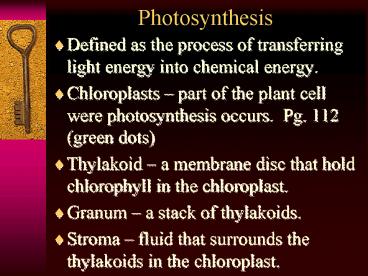Photosynthesis - PowerPoint PPT Presentation
1 / 9
Title: Photosynthesis
1
Photosynthesis
- Defined as the process of transferring light
energy into chemical energy. - Chloroplasts part of the plant cell were
photosynthesis occurs. Pg. 112 (green dots) - Thylakoid a membrane disc that hold chlorophyll
in the chloroplast. - Granum a stack of thylakoids.
- Stroma fluid that surrounds the thylakoids in
the chloroplast.
2
The 3 reactions of photosynthesis
- 1. Light absorption by chlorophyll
- 2. Light Reaction
- 3. Calvin Cycle (dark reaction)
- So, what happens when light strikes a chlorophyll
molecule? - 1. Light is given off
- 2. Heat is given off
- 3. It is used to create energy
3
- The light causes the chlorophyll molecules to
vibrate and release electrons, which is
electrical energy. Then in the second phase the
electrical energy is converted to chemical
energy. - The transport of these electrons occurs in the
photosystems of the light reaction.
4
- Photosystem II is where electrons are used as
electrical energy. - Photosystem I is where electrons are used as
chemical energy. - The energy produced from both photosystems is
stored as ATP NADPH ? Stored Energy. - Pg. 114 115 ? Steps
5
Calvin Cycle
- The stored energy in the light reaction (ATP
NADPH) is used in the Calvin cycle. Also called
Dark Reaction or Light-independent Reaction. - CO2 is used to start the cycle. Hydrogen is then
added with the help of ATP NADPH to complete
the cycle, in which sugars are produced and
oxygen is released. - It stores sugars starches in the leaves.
- Plants stay alive for weeks without light because
of the stored sugars starches.
6
- Water Carbon Dioxide ? Glucose Oxygen as a
by-product - Glucose (C6H12O6) is produced in the Calvin cycle
(Dark Reaction). - Pg. 117 ? Steps
- Plants are autotrophs not mobile
- Animals are heterotrophs mobile
- All of the reactions take place in the
chloroplast of a plant cell (contains
chlorophyll) - Calvin Cycle ? stroma
- Light reactions ? thylakoid membrane
7
C4 vs. C3 Plants
- C4 plants are adapted to environments with high
temperatures and dry conditions. Produce more
sugars. - Produce a 4-carbon compound of PGA
- They have enzymes that enable this.
- Ex. Corn, crabgrass, buffalo grass, sugar cane
- Warm Season Plants
- C3 plants are adapted to cooler climates.
- Produce a 3-carbon compound of PGA
- Ex. Wheat, blue-grass, fescue
- Cool Season Plants
8
- CAM plants undergo a process where their stomata
are open at night closed during the day. Why
would they do this? Examples? - This occurs in very hot dry climates.
- Cactuses Pineapples
- Where does the energy come from in plants?
- What are the colors of visible light?
- ROYGBIV
- What color is most absorbed by plants?
9
- Plants use all the colors of the spectrum except
green. It reflects green the most. - Two types of chlorophyll ? A B.
- Chlorophyll A does photosynthesis, while
chlorophyll B helps. Chlorophyll A prefers the
red wavelength of visible light, which means most
plants should grow better with that wavelength.
Pg. 113 - During the fall plants start to lose their
chlorophyll and other accessory pigments are now
displayed. - Carotenoids, xanthophylls, anthocyanins































